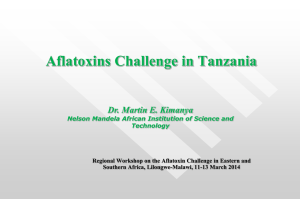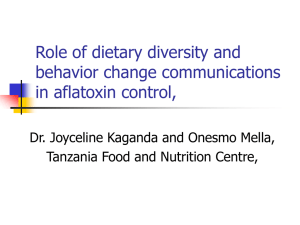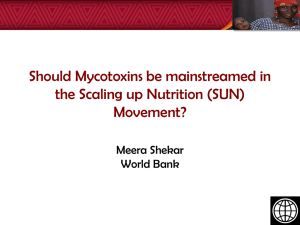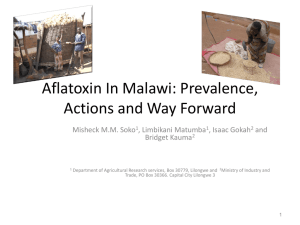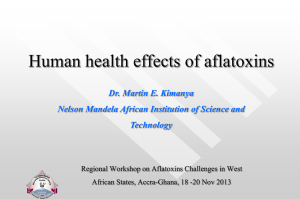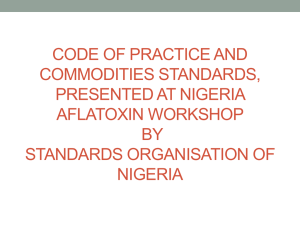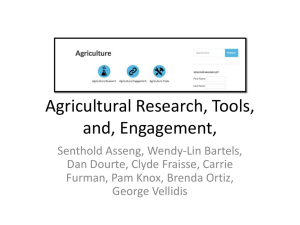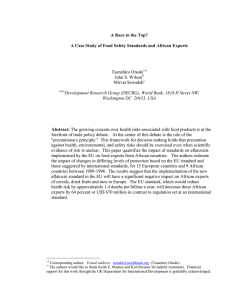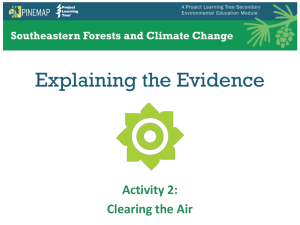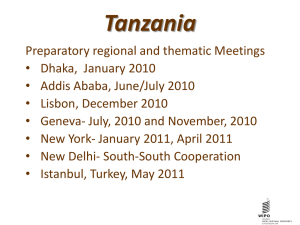WARSHA YA WAKULIMA NA WAJASILIAMALI
advertisement
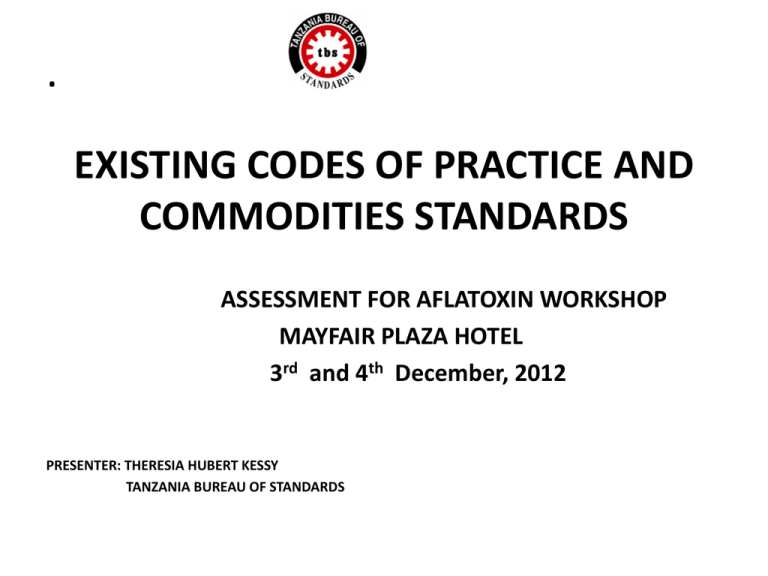
. EXISTING CODES OF PRACTICE AND COMMODITIES STANDARDS ASSESSMENT FOR AFLATOXIN WORKSHOP MAYFAIR PLAZA HOTEL 3rd and 4th December, 2012 PRESENTER: THERESIA HUBERT KESSY TANZANIA BUREAU OF STANDARDS . INTRODUCTION Tanzania Bureau of Standards (TBS) is Tanzania’s sole standards body established by Act No. 3 of 1975 and subsequently amended by Act No. 1 of 1977. The Standards Act No. 3 was later repealed and replaced by the Standards Act No. 2 of 2009. Tanzania Bureau of Standards (TBS) is under the Ministry of Industry and Trade. INTRO…… The main functions of TBS Formulation and promulgation of Tanzania standards in all sectors of the country’s economy. Undertake the testing of product samples drawn by providing facilities for the examination and testing . Implement the promulgated standards through third party Certification Schemes i.e approve, register and control the use of “standard mark” To undertake calibration of industrial and commercial measuring equipment and instruments in the areas of mass, length, volume, energy, temperature INTRO…… To promote standardization and quality assurance services in industry and commerce through training. Represents Tanzania in International, regional Standards bodies etc ( ISO , CODEX, EAC,ARSO) INTR…… SAFE FOOD Ensuring the safety of food has been a major concern at international and national level over the last few years. Food contamination concern involves physical, microbiological and chemical hazards. Among chemical hazards, the contamination of food and feed by aflatoxin , fishery products by phycotoxins and edible plant species by their plant toxins have been characterised as significant sources of food-borne illnesses (WHO) INTR…… Among the three categories of natural toxins, most attention has been directed to aflatoxins to date . Countries have established standards and regulations on aflatoxin in food and feed to safeguard the health of humans after the knowledge that it can have serious effects on humans and animals. AFLATOXIN CONTROL THROUGH STANDARDIZATION Response towards food safety challenges has focused on food standardisation. Tanzania Standards and Codes of Practice set by TBS are the main supporting documents useful for the control of Aflatoxins in Foods and feed. All Tanzania food Standards have a section for chemical contaminants and aflatoxins are stated or specified where relevant. Aflatoxin Limits Specifiedin National standards Due to lack of reliable aflatoxin levels of foods consumed locally; TBS adopts/adapts existing and relevant Codex Codes of Practice and standards for Prevention and Elimination of aflatoxins. All Tanzania new and revised food standards have the maximum limits for Aflatoxins as : - Total Aflatoxins – 10 mg/kg (ppb) - Aflatoxin B1 - 5 mg/kg (ppb) (with exception of baby foods : 1 mg/kg (ppb ) 5 mg/kg (ppb total & Tanzania Standards with specifications for Aflatoxin TBS, has set standards for maximum aflatoxin concentrations for several aflatoxin-susceptible products: i) Staple foods: - Cereals and their products( maize, wheat ,sorghum and millet ( grains& flours) - Roots, tubers and their products ( cassava and cassava flour and blended cassava four, cassava chips - pulses& legumes ( soya ,cow pea, beans ,pigeon pea ) ii) Oil seeds ( groundnuts, sesame seeds, cashew nuts) iii) Meat and meat products-(under revision) iv) Milk and milk products ( under revision) v) Infant foods ( cereal based infant and young children under revision ) vi) Animal and poultry feeds ( under revision) Tanzania Standards with specifications for Aflatoxins Standard code Title Aflatoxin limits TZS 328: Maize Flour – Specification 5 µg/kg (ppb) for aflatoxin B1 and 10µg for total aflatoxins. TZS 438: TZS 437: Maize Grain - Specification Wheat Grains- Specification 5 µg/kg (ppb) for aflatoxin B1 and 10µg for total aflatoxins. 5 µg/kg (ppb) for aflatoxin B1 and 10µg for total aflatoxins TZS 439: Wheat flour- specificatin 5 µg/kg (ppb) for aflatoxin B1 and 10µg for total aflatoxins TZS 765: Sorghum Flour-Specification 5 µg/kg (ppb) for aflatoxin B1 and 10µg for total aflatoxins Soya Beans -Specification 5 µg/kg (ppb) for aflatoxin B1 and 10µg for total aflatoxins Pearl millet/ bulbrush flour- SPec 5 µg/kg (ppb) for aflatoxin B1 and 10µg for total aflatoxins TZS 1083 TZS 874 Tanzania Standards……. TZS 688: Finger millet flour-Specifiation 5 µg/kg (ppb) for aflatoxin B1 and 10µg for total aflatoxins. TZS 466: Cassava Flour-Specification 5 µg/kg (ppb) for aflatoxin B1 and 10µg for total aflatoxins . 5 µg/kg (ppb) for aflatoxin B1 and 10µg for total aflatoxins TZS 592: Milled Rice - Specification TZS 465: Edible cassava chips Specification 5 µg/kg (ppb) for aflatoxin B1 and 10µg for total aflatoxins TZS 740: 2003 Groundnuts (peanuts) – Specification 5 µg/kg (ppb) for aflatoxin B1 and 10µg for total aflatoxins TZS 180 : Processed cereal – Based weaning foods – Specification 1 µg/kg (ppb) for aflatoxin B1 and 5 µg for total aflatoxins TZS 741: Simsim (sesame) seeds – Specification 5 µg/kg (ppb) for aflatoxin B1 and 10µg for total aflatoxins CHALLENGES Available Aflatoxin standards do to address a large share of foods consumed by Tanzanian people ( unpackaged indigenous/local foods in the market) Inadequate collection of analyzed nationally representative data confirmed as quantitative findings from research to be referred in setting national standards for aflatoxins. TBS laboratory does no not have capacity to conduct aflatoxin testing as one among the food safety control institutions. Inadequate awareness of aflatoxin standards in the food chain( e.g farmers WAY FORWARD TBS to upgrade standards and codes to reflect ranges of consumption (basing on local /indigenous consumption e .g staple foods and nuts) . TBS to develop national standards that account for consumption patterns building on the Codex Alimentarius, consistent with the World Trade Organization Sanitary and Phytosanitary Agreement. Enforcement of aflatoxin standards in aflatoxinsusceptible products. Collaboration of stakeholders on aflatoxin control and setting up a policy .
